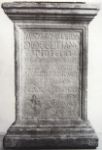
 
 
 
 
|
DiscussionBase for statue of Diocletian, emperor; erected to its patron by the guild of carpenters (fabri tignuarii). From Ostia (hinterland of Rome). 285. INSCRIPTION:
In ten lines. Letter height 6.5-3.5 cm.
Imp(eratori) Caes(ari) C(aio) Valerio / Diocletiano, / pio, felici, / invicto Aug(usto), pontif(ici) max(imo), /(5) Brittannic(o) max(imo), Germ(anico) / max(imo), trib(unicia) potest(ate) II, co(n)s(uli) II, / p(atri) p(atriae), proco(n)s(uli). / Honorati et decurion(es) / et numerus militum /(10) caligatorum.
'To the emperor Caesar Caius Valerius Diocletianus, pious, fortunate, unconquered Augustus, highest priest (pontifex maximus), greatest victor over the British peoples, greatest victor over the Germanic peoples, holding the tribunician power for the second time, consul for the second time, father of the country, proconsul. The holders of distinction (honorati), the decurions, and the soldiers of the lower ranks (set this up).'
The inscription records the dedication of a statue to Diocletian by members of the guild of the Fabri Tignuarii, who are not mentioned as a guild, but as its different components (honorati, decuriones and milites caligati).
DESCRIPTION:
White marble base, 125 x 84 x 58 cm. The epigraphic field measures 74 x 49 cm, and it is framed by moulding. An earlier inscription was chiselled out, in order to make way to our dedication. The original dating inscription (from A.D. 200-204) survives on the right side. The right side has a patera and the left side an urceus (Østergaard).
PROVENANCE AND LOCATION:
The base was first seen in Rome, and was published as CIL VI, 1116. It actually comes from Ostia, from an uncertain provenance. It is now in Kopenhagen, at the Ny Carlsberg Glyptotek.
HONORAND, AWARDER AND DATE:
The emperor Diocletian held the tribunician power and the consulship for the second time in 285 (Kienast). the base was set up by the guild of the construction workers of Ostia, the Fabri tignuarii. The guild is presented with its different elements, the honorati, the decurions (leaders of each of the 16 decuriae), and its lowest members, traditionally described as soldiers. This corporation was organized according to a military model (Cébeillac-Gervasoni, Caldelli and Zevi 2006, 236-237).
Carlos Machado
Main Reference
Østergaard, J. S., Catalogue. Imperial Rome. Ny Carlsbeg Glyptotek, Kopenhagen 1996, n. 205
Østergaard, J. S., Catalogue. Imperial Rome. Ny Carlsbeg Glyptotek, Kopenhagen 1996, n. 205
Corpus Inscriptionum Latinarum; , XIV, 128 (+p 613) = CIL VI, 1116 (+p. 4325)
Discussion References
Cébeillac-Gervasoni, M.; M. L. Caldelli and F. Zevi, Épigraphie Latine, Paris 2006, p. 236-237
Kienast, D., Römische Kaisertabelle : Grundzüge einer römischen Kaiserchronologie, Darmstadt, 1996, p. 267
|

